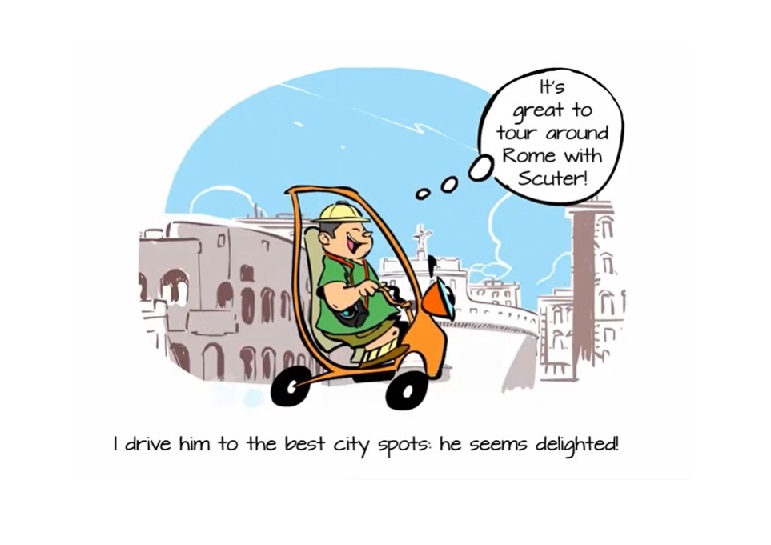‘Sharing mobility’ is well established in a lot of Italian cities. Mobility and sustainability are at the centre of many political debates. Often the adopted solutions for problems such as bike and scooter unruly parking are a headache cause s for to the many municipalities. At the moment, present, we can say that we are in a ‘beginning’ phase where, on the one hand in a side there is a need to satisfy the strong demand, and in on the other there are the various vendors (operators) who are trying their best to make their product as appealing as possible to users.
In this latter regard, Scuter fits the bill. It is an Italian startup that is he’s vertically integrating itself into the sharing mobility revolution by offering not only an innovative service, but also using a new means (mode) of transport designed specifically for shared mobility in cities.
Today, we have the pleasure of interviewing Gianmarco Carnovale, Scooter’s founder, in order to better understand better Scuter’s world.
1)“— first of all, I want you to tell us what Scuter is?”
Scuter is an urban mobility system and an environmentally sustainable infrastructure built around the first electric vehicles designed for the ‘sharing mobility’ innovation. Scuter offers a viable alternative for every-day user mobility. It avoids the use of conventional or individual vehicles in order to move from ‘A’ to ‘B’ while at the same time providing safety, agility, ease and respect for the environment. In addition, Scuter addresses the large amount of data input now available along with energy concerns.
2) Who or what are you targeting?
We’re targeting a wide range of customers. If we talk about the individual users, we mean those who need to be transported for purposes of work, study and all the other reasons that motivate people to move. These same people may be choosing ‘sharing mobility’ as a solution that benefits the community as a whole. In a broader sense, our customers are the cities to which Scuter can contribute a significant impact in terms of efficiency and sustainability.
3) What is your mission?”
Our mission is to make travel safe, sustainable and simple for our customers, while at the same time reducing pollution and some of the negative features of traffic.
4) Where did the idea come from?
The idea came from a meeting between the co-founders, each of whom has a diverse business backgroung and experience: Gianmarco Carnovale from the startup and innovation world, Gabriele Carbucicchio and Carmine Di Nuzzo from the motorcycle industry and Luca Ruggeri from telecommunications.
Together with the input of a large utility, the four instigators started thinking about a ‘sharing mobility’ model … in that period there were the two original car-sharing national operators in Europe and Korea and a scooter-sharing start-up in California in the USA.
Beyond recognising the immediate computer-enabled opportunities, the four immediately realised that using commercial vehicles from other operators could be more trouble than it was worth, especially if you are using cars which, although shared, involve queuing and the need for parking space. Scooters have practical limitations as-well-as a more limited user-pool than cars, seasonal and inclement weather disturbances and mandatory helmet laws all collude to make scooters impractical for the needs of ‘sharing mobility’.
The real limiting factor for ‘sharing mobility’ is, however, the fact that existing vehicles have never been designed for the unique needs of sharing.
So the four innovators started to design something with features never seen before in one package: a nimble, yet stable three-wheeled compact scooter-inspired electric vehicle with a comfortable protective passenger cell operating at traffic-compatible speeds … and being easy to park. A rugged and durable environmentally-sustainable, high-strength car-like-hybrid designed for intensive use, complete with internal safety restraints obviating the need inconvenient safety helmets.
From design stage we’re already into 3D print modelling with an almost full-sized driveable prototype nearing completion. An enhanced version with some bicycle features will be followed by a street-ready lighter version incorporating high-strength composite materials. To launch the service, a ‘fifth generation vehicle’ will go into series production. Future concepts are already on the ‘drawing boards’.
5) As we well know, one of the problems of ‘Sharing Mobility’ is the unruly bike and scooter ‘parking’. Would not your system be subject to similar problems?
Unruly parking was one the main problems we had to resolve. Our vehicles will weigh about 100 kg, obviously far more than a scooter or bike, and as such virtually impossible for a person to lift onto the footpath. They will be licensed and the actual driver can be sanctioned if laws are broken. The Italian traffic code enables us to charge those who park in an unruly manner and so will oblige drivers to be responsible … thus drastically reducing parking problems. Over time we plan to introduce computer vision, so the vehicle itself reports in real time whether or not the driver has parked correctly … and if not, the ride will be interrupted.
6) Are your vehicles just for big urban centres or do you think they are more suitable for small provincial towns?
After the first big Italian city launch, we are targeting market-entry in other big Italian cities as well as in Europe. For small towns, we would like to work in an indirect manner by having a dialogue with municipal and local transport authorities and energy companies with the aim to build partnerships. Basically we’re saying that we’ll prioritize the big centers which are now plagued by traffic and smog problems, then follow-up in medium-sized cities and maybe even small towns.
7) When will we see your vehicles operating regularly in our cities?
Optimizing the final details for a fleet launch is harder than it seems. Apart from permits, there are such concerns as operating-area studies, logistics, maintenance and vehicle cleaning, communication planning, customer call-centers and process automation to be dealt with. The work-arounds needed for ‘sharing mobility’services are many, but as day zero approaches, they are becoming less and less.
Scuter’s link:

